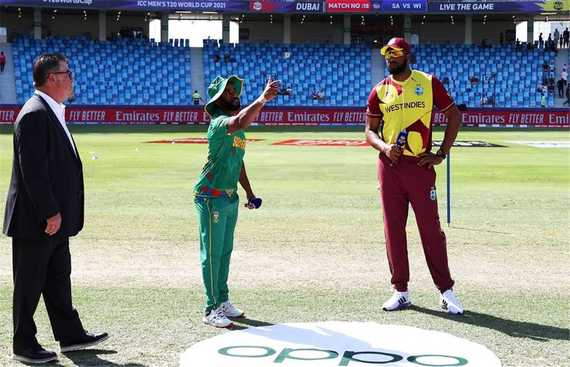Dew in the desert, flip of the coin proving decisive at T20 World Cup

Cricket is a sport which is played professionally on large playgrounds and 22 yards, but ironically small margins and key components like toss, nature of the pitch, dew, right playing XI, etc decide the outcome of the game.
In the ongoing Men's T20 World Cup, the flip of the coin and dew are making a huge impact on the result of every game. With nine of 10 winners so far in the Super 12 stage of the mega event coming from the team batting second, winning the toss is proving a key element.
As a result, the captain winning the toss has no hesitation in electing to field.
So the formula for captains and the teams in the UAE has been simple: win the toss, bowl first, chase down the total and win. The only exception has been Afghanistan's 130-run hammering of Scotland, where the order of innings was irrelevant.
And it's not happening for the first or last time on a cricket playground. Dew was also a concern in the previous editions of T20 World Cups. It was also evident in IPL matches played on the same three venues in the UAE in the past month, with the chasing team winning 15 of the last 20 games.
Captain's corner
After Team India's crushing 10-wicket defeat against arch-rivals Pakistan, Virat Kohli had admitted that teams chasing will have an advantage with the dew setting in during the night games.
The skipper felt that toss will be crucial as it was the case when Pakistan put India in to bat. Notably, Pakistan has won both their matches while chasing and dew was certainly a crucial factor in their win against India and New Zealand.
"Yes, toss definitely is going to be a factor in this tournament. Especially, if the dew keeps creeping in in the latter half of the game... you need those extra runs in the first half then," Kohli said.
While Kohli mentioned that pitch wasn't exactly difficult when they batted but it certainly became a touch easier in the second half when Pakistan openers Mohammed Rizwan and Babar Azam faced the Indian attack.
"If the pitch becomes a little better to bat on and you get off to a start, then you start feeling more confident about the chase. That's what happened," he explained.
"The dew came in towards the second half of the Pakistan innings, 10 overs onwards. We could not even get dot balls in because the pitch was obviously providing a big pace for the batsman to work with. The slower balls were not holding up as much," he added.
Challenges created by dew
Grip and control: The dew factor in cricket is the phenomenon caused due to the excessive moisture present on the cricket field during the night which makes the ball moist. With the ball becoming moist and slippery, it is always difficult to grip and control, directly affecting the bowler's line and length and making it easier for batters.
Pitch: The dew also causes change in the nature of the pitch. It becomes much flatter, cracks on the surface are not widened and batters find it easy to counter the threat of spin and swing to an extent.
Fielding: The fielders too find it difficult to grab or throw a dew-affected wet ball. Even the best fielders in the world struggle to give their best while fielding if the ball is wet.
Road Ahead
In their upcoming game against New Zealand, the Indian team can try different things to deal with the dew factor.
Practicing with a wet ball: It's not the perfect solution to negate the dew factor in the ground. But, using a wet ball during practice can make sure that the players are able to grip the wet ball similar to what they will be getting in a match situation.
Bowling the right length: The Indian bowlers should look to bowl the right length against the Kiwis. The best available option for pacers is to bowl the hard lengths. It's never easy to bowl the desired lenght when the ball is wet, but if one can master it then it becomes the key to success. Because slippery balls don't allow bowlers to bowl even yorker-length deliveries.
Picking the best playing XI: With the ball becoming wet in dewy conditions, a wrist spinner could be a better bet for India than a finger spinner against New Zealand. Notably, Rahul Chahar is the only wrist spinner in the Indian squad at the moment. Both Ravichandran Ashwin and Ravindra Jadeja are finger spinners with Varun Chakravarthy adding his mystery element to the spin department.
The inclusion of more spinners in the playing XI or continuing with similar set-up will be also a debating factor in the Indian team management at this point
